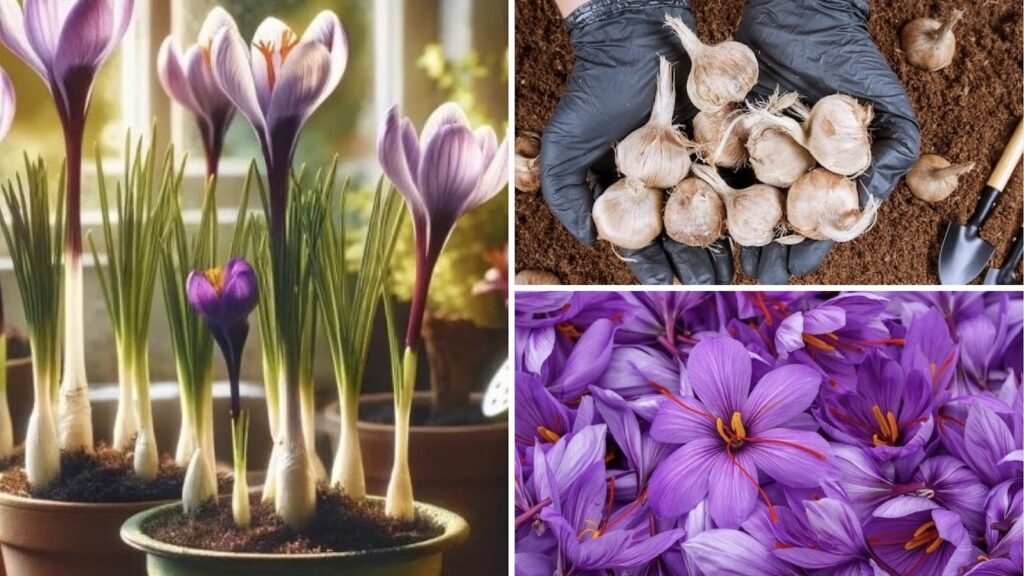If you’ve ever wanted to grow saffron at home, you’re in luck today! Saffron is known as one of the most expensive spices in the world. But did you know that you can cultivate it right in your own backyard or even indoors?
Source: Pinterest
With the right conditions and a little care, you can enjoy your very own homegrown saffron in no time. Below, we’ve got 10 expert tips and tricks to help you get started on your saffron-growing journey. But first, can you grow saffron at home?
Can I Grow Saffron at Home?
Absolutely! The key is to make sure you have the right soil conditions. Saffron bulbs prefer loose, sandy soil that drains well.
Source: Pinterest
If your soil is too heavy, consider adding sand or organic matter to improve its texture. For indoor saffron growing, use a potting mix that offers similar drainage. Wondering how to grow saffron at home? The tips below will help.
Start with the Right Bulbs
One of the most important steps when you want to grow saffron indoors is to start with high-quality Crocus sativus bulbs.
Source: Pinterest
These bulbs thrive in well-drained soil and require plenty of sunlight. This is why it’s essential to position them in a sunny spot if you’re growing saffron indoors. This will ensure that your saffron plants grow healthy and strong.
Proper Spacing for Homegrown Saffron
When planting your bulbs to grow saffron at home, it’s crucial to space them correctly. Make sure you plant each bulb about 3-4 inches deep and leave a few inches between each bulb.
Source: Pinterest
This spacing ensures that your homegrown saffron has enough room to spread its roots and grow healthily.
Timing is Key: Plant Your Bulbs in the Fall
The best time to plant saffron bulbs is in the fall, as they need cooler temperatures to grow.
Source: Pinterest
If you’re learning how to grow saffron, remember that fall planting allows the bulbs to establish themselves before winter. This in turn leads to a successful harvest the following year.
Watering Your Saffron: Don’t Overdo It!
One common mistake when learning how to plant and grow saffron is overwatering. Saffron bulbs don’t need much water once they’re established.
Source: Pinterest
So, water them sparingly, ensuring that the soil stays moist but not soggy. Too much water can cause the bulbs to rot, so it’s better to be underwater than overwater.
Fertilizing Your Saffron Plants
Fertilization is another important factor when you want to grow saffron at home. Use a balanced, all-purpose fertilizer during the growing season to give your plants the nutrients they need.
Source: Pinterest
This is especially important if you’re growing saffron indoors, as potted plants may require more nutrients than those grown in the ground.
Harvesting Your Homegrown Saffron
One of the most rewarding aspects of learning how to grow saffron indoors or outdoors is the harvest! Once the saffron flowers bloom, you’ll notice the vibrant red stigmas inside.
Source: Pinterest
Carefully pluck these stigmas by hand and dry them in a cool, dark place for about a week. This dried saffron is the spice you’ll use in cooking.
Storing Your Harvested Saffron
After harvesting your homegrown saffron, proper storage is key to maintaining its flavor and potency. Store the dried saffron stigmas in an airtight container in a cool, dark place.
Source: Pinterest
This will keep your saffron fresh and flavorful for up to two years.
Protect Your Saffron from Pests
When you grow saffron at home, pests like rodents and insects can sometimes be a problem. To protect your bulbs, consider using natural pest repellents or covering your bulbs with a light layer of mulch.
Source: Pinterest
If you’re growing saffron indoors, make sure to keep the area clean and free of pests.
Be Patient: Saffron Takes Time
Saffron is not a plant that provides instant gratification. It takes time for the bulbs to establish and for the flowers to bloom. However, once you’ve mastered how to grow saffron indoors or outdoors, you’ll find the wait worthwhile.
Source: Pinterest
With a little patience, you’ll be rewarded with one of the most prized spices in the world.
Bonus Point: Consistency is Key for Saffron Success
Whether you’re learning how to plant and grow saffron for the first time or you’re a seasoned gardener, consistency is crucial. Maintain a regular watering schedule, keep an eye on the soil, and protect your bulbs from pests.
Source: Pinterest
With dedication and attention, you can successfully grow saffron at home and enjoy the fruits (or rather, the stigmas) of your labor.
